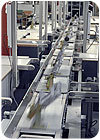
A little over 300 years ago-in 1689 to be precise-King Charles XI of Sweden decreed that a weapons factory be built in the town of Huskvarna. A few decades later, some of the artisans working there switched from crafting firearms to making a peaceful precision product-sewing machines. The resulting company, now Viking Sewing Machines AB, has been hard at it ever since.
Today, the company is not only one of the world’s oldest manufacturers, but also one of the most advanced. Gone are the days when sewing machines were assembled meticulously by hand. Instead, the company uses automation and flexible manufacturing whenever possible to increase throughput and efficiency, as well as the quality of its products.
A few years ago, the company implemented a complete Dynamic Assembly System (DAS) from automation equipment manufacturer FlexLink (Allentown, PA), and the system has been going strong ever since. Comprised of both software and hardware, the DAS system assembles, tests, transports and packages Viking Sewing Machines’ Designer 1 model, a computer-controlled machine that can do everything from buttonholes to embroidery.
In addition to regulating production flow, the mixed-mode, pallet-based system also enhances operator health and safety through the implementation of various ergonomic features. The manual portion of the assembly line includes seven workstations, with six additional workstations providing spare assembly capacity. The system is flexible and easy to adjust in response to product or capacity changes.
Processing times for the different stations range from 6 to 9 minutes. Before packaging, every sewing machine undergoes a 12-minute automated functional test. When they reach the end of the line, the pallets automatically return to the starting point, where they are prepped for another sewing machine.
“The assembly work follows a computerized route handled by a computer, and the actual route can be followed on the screen,” says Viking Sewing Machines production engineer Olof Dahlin. “If there is no station available, the pallet will circulate on the line until an assembly station becomes available. On our old production lines, you had to follow a sequential flow, taking the stations in order, without any possibility of changing assembly steps or the defined role at each workstation.”
Dahlin adds that the line is also much easier on employees than in the past. “Ergonomic adaptation of each workstation is very important for us,” he says, adding that a physiotherapist has inspected, tested and approved the entire line.
For more on conveyors and assembly systems, call 610-973-8200 or visitwww.flexlink.com.